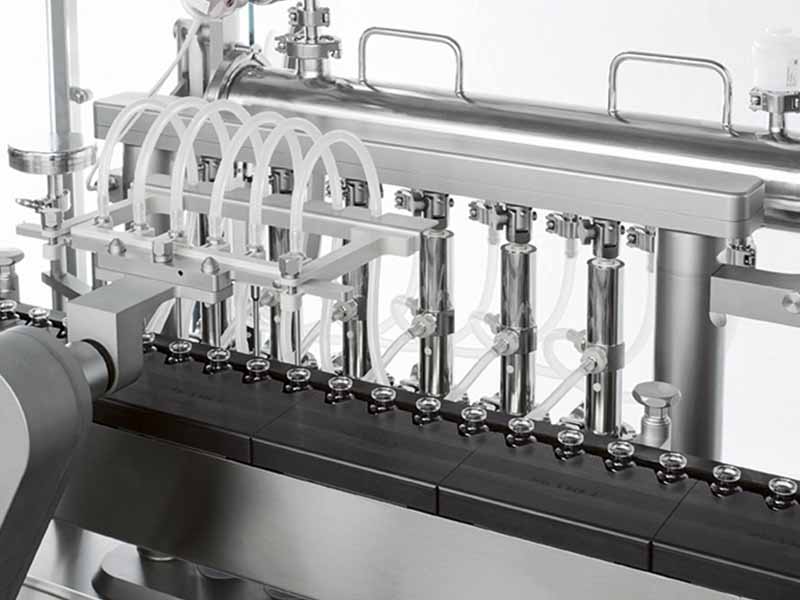Vaccines have received much attention in recent years. It is understood that the vaccine industry chain involves multiple links such as packaging materials, transportation and storage, vaccination and injection, so there are also huge potential market opportunities.
1 Vaccine And Pre-Filled Needle Filling Equipment May Usher In Development
Packaging Materials: Borosilicate Medicinal Glass Becomes The Upgrading Direction
In terms of packaging materials, the packaging materials for vaccines are mainly medicinal glass. At present, the medical glass in China’s domestic market is mainly low-borosilicate glass and soda-lime glass. This type of glass is easy to react with the liquid medicine, which makes the medicine contaminated to a certain extent. With the advancement of policies such as consistency evaluation, related review and approval, and volume-based procurement, China’s pharmaceutical industry is constantly upgrading, and the requirements for pharmaceutical packaging are also increasing. In this context, medicinal glass needs to be upgraded urgently, and medium borosilicate glass with more stable properties has become an important direction for upgrading medicinal glass. It is predicted that in the next 5 to 10 years, 30 to 40% of China’s 300,000 tons of medical glass will be upgraded from low borosilicate glass to medium borosilicate glass.
Rubber Plug: The Production Capacity Of Domestic Enterprises Is Being Gradually Released

In addition to medium borosilicate glass, rubber stoppers are also an essential accessory for vaccine bottles. For example, vials need to be equipped with a rubber stopper and aluminum cap. It is understood that the stoppers of general vials are made of halogenated butyl rubber, which has the characteristics of good airtightness, water resistance, and heat resistance. In recent years, the production capacity of some domestic enterprises has been gradually released, ushering in development opportunities.
Pre-Filled Needle Technology Is Expected To Become A Trend, And Related Filling Equipment May Usher In Explosive Development
Recently, pre-filled needles and their production lines have also become the focus of market attention. Judging from the current situation of various vaccine companies, most of them use pre-filled needle technology. It is understood that there are two main advantages of the pre-filled needle technology, one is easy to use and fast injection efficiency; the other is that it can avoid pollution and passivation of the needle tip caused by puncturing rubber during the liquid dispensing process, and produces less medical waste. Some people in the industry believe that in the case of a shortage of vaccine glass bottles, the existing ampoules and Xining bottles may be eliminated, and pre-filled needle technology has become a development trend.
It is worth mentioning that although prefilled needles have obvious advantages, they also have the disadvantages of large volume, inconvenient transportation and storage. In addition, compared with the combination of “glass bottle + syringe”, the price of the prefilled needle is also more expensive.
Transportation And Storage: Refrigeration Equipment Will Play An Important Role
The distribution of vaccines requires a full cold chain to ensure the safety and effectiveness of vaccine products. In the process of transportation and storage, related refrigeration equipment will play an important role. At present, leading companies in the vaccine cold chain such as Aucma, Snowman, and Daleng have established vaccine-related cold chain systems. In addition, courier companies such as SF Express have also obtained the cold chain delivery qualification for Class II vaccines. It is foreseeable that the competition in the cold chain market will become increasingly fierce.
2 Filling Method Of Drug Pre-Filled Needle Aseptic Filling Process
Protein-based therapeutics have become a major driver of growth in the pharmaceutical industry, and the drug development pipeline is flooded with related biologics. Because these large and complex molecules are extremely unstable, they face great challenges in the production process. Filling of aseptic preparations is particularly critical as the last link throughout the drug development and clinical treatment production stages.
According to the different filling methods of products, the filling is divided into three types: ordinary filling, nitrogen filling and vacuum filling. Professional biologics CDMO service providers will choose different filling methods according to product requirements.
1) Ordinary Filling
The filling process does not require vacuum and inflation, and the liquid medicine is directly filled into the syringe and then plugged. The disadvantage of ordinary filling is that there are air bubbles in the syringe, which is not easy to cork, so you can choose the sleeve cork method when filling. The method is suitable for the production of most solution-type injections and vaccines, and is suitable for high-speed filling with high speed.
2) Filling With Nitrogen
Products sensitive to oxygen can choose a nitrogen filling protection device. According to the different nitrogen filling time, there are three methods: simultaneous nitrogen filling for filling hollow tubes, supplementary nitrogen filling between filling and tamping, and nitrogen filling for tamping sleeves. It can ensure that the whole process of liquid medicine filling and plugging is completed under the protection of nitrogen, so as to ensure that the residual oxygen in the medicine is low.
3) Vacuum Filling
Vacuum filling can be used when the product has high viscosity or is sensitive to air. Vacuum the syringe before adding liquid, fill the syringe with nitrogen and release it after adding liquid, transfer the syringe to the stoppering station, press the stopper after vacuuming, and then carry out nitrogen-filled release after the stoppering is completed. The appearance of vacuum filled products has little or no bubbles.










